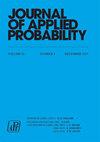求助PDF
{"title":"平方极值点上的相干分布和渐近线","authors":"Stanisław Cichomski, Adam Osękowski","doi":"10.1017/jpr.2024.1","DOIUrl":null,"url":null,"abstract":"Let <jats:inline-formula> <jats:alternatives> <jats:inline-graphic xmlns:xlink=\"http://www.w3.org/1999/xlink\" mime-subtype=\"png\" xlink:href=\"S0021900224000019_inline1.png\" /> <jats:tex-math> $\\mathcal{C}$ </jats:tex-math> </jats:alternatives> </jats:inline-formula> denote the family of all coherent distributions on the unit square <jats:inline-formula> <jats:alternatives> <jats:inline-graphic xmlns:xlink=\"http://www.w3.org/1999/xlink\" mime-subtype=\"png\" xlink:href=\"S0021900224000019_inline2.png\" /> <jats:tex-math> $[0,1]^2$ </jats:tex-math> </jats:alternatives> </jats:inline-formula>, i.e. all those probability measures <jats:inline-formula> <jats:alternatives> <jats:inline-graphic xmlns:xlink=\"http://www.w3.org/1999/xlink\" mime-subtype=\"png\" xlink:href=\"S0021900224000019_inline3.png\" /> <jats:tex-math> $\\mu$ </jats:tex-math> </jats:alternatives> </jats:inline-formula> for which there exists a random vector <jats:inline-formula> <jats:alternatives> <jats:inline-graphic xmlns:xlink=\"http://www.w3.org/1999/xlink\" mime-subtype=\"png\" xlink:href=\"S0021900224000019_inline4.png\" /> <jats:tex-math> $(X,Y)\\sim \\mu$ </jats:tex-math> </jats:alternatives> </jats:inline-formula>, a pair <jats:inline-formula> <jats:alternatives> <jats:inline-graphic xmlns:xlink=\"http://www.w3.org/1999/xlink\" mime-subtype=\"png\" xlink:href=\"S0021900224000019_inline5.png\" /> <jats:tex-math> $(\\mathcal{G},\\mathcal{H})$ </jats:tex-math> </jats:alternatives> </jats:inline-formula> of <jats:inline-formula> <jats:alternatives> <jats:inline-graphic xmlns:xlink=\"http://www.w3.org/1999/xlink\" mime-subtype=\"png\" xlink:href=\"S0021900224000019_inline6.png\" /> <jats:tex-math> $\\sigma$ </jats:tex-math> </jats:alternatives> </jats:inline-formula>-fields, and an event <jats:italic>E</jats:italic> such that <jats:inline-formula> <jats:alternatives> <jats:inline-graphic xmlns:xlink=\"http://www.w3.org/1999/xlink\" mime-subtype=\"png\" xlink:href=\"S0021900224000019_inline7.png\" /> <jats:tex-math> $X=\\mathbb{P}(E\\mid\\mathcal{G})$ </jats:tex-math> </jats:alternatives> </jats:inline-formula>, <jats:inline-formula> <jats:alternatives> <jats:inline-graphic xmlns:xlink=\"http://www.w3.org/1999/xlink\" mime-subtype=\"png\" xlink:href=\"S0021900224000019_inline8.png\" /> <jats:tex-math> $Y=\\mathbb{P}(E\\mid\\mathcal{H})$ </jats:tex-math> </jats:alternatives> </jats:inline-formula> almost surely. We examine the set <jats:inline-formula> <jats:alternatives> <jats:inline-graphic xmlns:xlink=\"http://www.w3.org/1999/xlink\" mime-subtype=\"png\" xlink:href=\"S0021900224000019_inline9.png\" /> <jats:tex-math> $\\mathrm{ext}(\\mathcal{C})$ </jats:tex-math> </jats:alternatives> </jats:inline-formula> of extreme points of <jats:inline-formula> <jats:alternatives> <jats:inline-graphic xmlns:xlink=\"http://www.w3.org/1999/xlink\" mime-subtype=\"png\" xlink:href=\"S0021900224000019_inline10.png\" /> <jats:tex-math> $\\mathcal{C}$ </jats:tex-math> </jats:alternatives> </jats:inline-formula> and provide its general characterisation. Moreover, we establish several structural properties of finitely-supported elements of <jats:inline-formula> <jats:alternatives> <jats:inline-graphic xmlns:xlink=\"http://www.w3.org/1999/xlink\" mime-subtype=\"png\" xlink:href=\"S0021900224000019_inline11.png\" /> <jats:tex-math> $\\mathrm{ext}(\\mathcal{C})$ </jats:tex-math> </jats:alternatives> </jats:inline-formula>. We apply these results to obtain the asymptotic sharp bound <jats:inline-formula> <jats:alternatives> <jats:inline-graphic xmlns:xlink=\"http://www.w3.org/1999/xlink\" mime-subtype=\"png\" xlink:href=\"S0021900224000019_inline12.png\" /> <jats:tex-math> $\\lim_{\\alpha \\to \\infty}\\alpha\\cdot(\\sup_{(X,Y)\\in \\mathcal{C}}\\mathbb{E}|X-Y|^{\\alpha}) = {2}/{\\mathrm{e}}$ </jats:tex-math> </jats:alternatives> </jats:inline-formula>.","PeriodicalId":50256,"journal":{"name":"Journal of Applied Probability","volume":"53 1","pages":""},"PeriodicalIF":0.7000,"publicationDate":"2024-04-05","publicationTypes":"Journal Article","fieldsOfStudy":null,"isOpenAccess":false,"openAccessPdf":"","citationCount":"0","resultStr":"{\"title\":\"Coherent distributions on the square–extreme points and asymptotics\",\"authors\":\"Stanisław Cichomski, Adam Osękowski\",\"doi\":\"10.1017/jpr.2024.1\",\"DOIUrl\":null,\"url\":null,\"abstract\":\"Let <jats:inline-formula> <jats:alternatives> <jats:inline-graphic xmlns:xlink=\\\"http://www.w3.org/1999/xlink\\\" mime-subtype=\\\"png\\\" xlink:href=\\\"S0021900224000019_inline1.png\\\" /> <jats:tex-math> $\\\\mathcal{C}$ </jats:tex-math> </jats:alternatives> </jats:inline-formula> denote the family of all coherent distributions on the unit square <jats:inline-formula> <jats:alternatives> <jats:inline-graphic xmlns:xlink=\\\"http://www.w3.org/1999/xlink\\\" mime-subtype=\\\"png\\\" xlink:href=\\\"S0021900224000019_inline2.png\\\" /> <jats:tex-math> $[0,1]^2$ </jats:tex-math> </jats:alternatives> </jats:inline-formula>, i.e. all those probability measures <jats:inline-formula> <jats:alternatives> <jats:inline-graphic xmlns:xlink=\\\"http://www.w3.org/1999/xlink\\\" mime-subtype=\\\"png\\\" xlink:href=\\\"S0021900224000019_inline3.png\\\" /> <jats:tex-math> $\\\\mu$ </jats:tex-math> </jats:alternatives> </jats:inline-formula> for which there exists a random vector <jats:inline-formula> <jats:alternatives> <jats:inline-graphic xmlns:xlink=\\\"http://www.w3.org/1999/xlink\\\" mime-subtype=\\\"png\\\" xlink:href=\\\"S0021900224000019_inline4.png\\\" /> <jats:tex-math> $(X,Y)\\\\sim \\\\mu$ </jats:tex-math> </jats:alternatives> </jats:inline-formula>, a pair <jats:inline-formula> <jats:alternatives> <jats:inline-graphic xmlns:xlink=\\\"http://www.w3.org/1999/xlink\\\" mime-subtype=\\\"png\\\" xlink:href=\\\"S0021900224000019_inline5.png\\\" /> <jats:tex-math> $(\\\\mathcal{G},\\\\mathcal{H})$ </jats:tex-math> </jats:alternatives> </jats:inline-formula> of <jats:inline-formula> <jats:alternatives> <jats:inline-graphic xmlns:xlink=\\\"http://www.w3.org/1999/xlink\\\" mime-subtype=\\\"png\\\" xlink:href=\\\"S0021900224000019_inline6.png\\\" /> <jats:tex-math> $\\\\sigma$ </jats:tex-math> </jats:alternatives> </jats:inline-formula>-fields, and an event <jats:italic>E</jats:italic> such that <jats:inline-formula> <jats:alternatives> <jats:inline-graphic xmlns:xlink=\\\"http://www.w3.org/1999/xlink\\\" mime-subtype=\\\"png\\\" xlink:href=\\\"S0021900224000019_inline7.png\\\" /> <jats:tex-math> $X=\\\\mathbb{P}(E\\\\mid\\\\mathcal{G})$ </jats:tex-math> </jats:alternatives> </jats:inline-formula>, <jats:inline-formula> <jats:alternatives> <jats:inline-graphic xmlns:xlink=\\\"http://www.w3.org/1999/xlink\\\" mime-subtype=\\\"png\\\" xlink:href=\\\"S0021900224000019_inline8.png\\\" /> <jats:tex-math> $Y=\\\\mathbb{P}(E\\\\mid\\\\mathcal{H})$ </jats:tex-math> </jats:alternatives> </jats:inline-formula> almost surely. We examine the set <jats:inline-formula> <jats:alternatives> <jats:inline-graphic xmlns:xlink=\\\"http://www.w3.org/1999/xlink\\\" mime-subtype=\\\"png\\\" xlink:href=\\\"S0021900224000019_inline9.png\\\" /> <jats:tex-math> $\\\\mathrm{ext}(\\\\mathcal{C})$ </jats:tex-math> </jats:alternatives> </jats:inline-formula> of extreme points of <jats:inline-formula> <jats:alternatives> <jats:inline-graphic xmlns:xlink=\\\"http://www.w3.org/1999/xlink\\\" mime-subtype=\\\"png\\\" xlink:href=\\\"S0021900224000019_inline10.png\\\" /> <jats:tex-math> $\\\\mathcal{C}$ </jats:tex-math> </jats:alternatives> </jats:inline-formula> and provide its general characterisation. Moreover, we establish several structural properties of finitely-supported elements of <jats:inline-formula> <jats:alternatives> <jats:inline-graphic xmlns:xlink=\\\"http://www.w3.org/1999/xlink\\\" mime-subtype=\\\"png\\\" xlink:href=\\\"S0021900224000019_inline11.png\\\" /> <jats:tex-math> $\\\\mathrm{ext}(\\\\mathcal{C})$ </jats:tex-math> </jats:alternatives> </jats:inline-formula>. We apply these results to obtain the asymptotic sharp bound <jats:inline-formula> <jats:alternatives> <jats:inline-graphic xmlns:xlink=\\\"http://www.w3.org/1999/xlink\\\" mime-subtype=\\\"png\\\" xlink:href=\\\"S0021900224000019_inline12.png\\\" /> <jats:tex-math> $\\\\lim_{\\\\alpha \\\\to \\\\infty}\\\\alpha\\\\cdot(\\\\sup_{(X,Y)\\\\in \\\\mathcal{C}}\\\\mathbb{E}|X-Y|^{\\\\alpha}) = {2}/{\\\\mathrm{e}}$ </jats:tex-math> </jats:alternatives> </jats:inline-formula>.\",\"PeriodicalId\":50256,\"journal\":{\"name\":\"Journal of Applied Probability\",\"volume\":\"53 1\",\"pages\":\"\"},\"PeriodicalIF\":0.7000,\"publicationDate\":\"2024-04-05\",\"publicationTypes\":\"Journal Article\",\"fieldsOfStudy\":null,\"isOpenAccess\":false,\"openAccessPdf\":\"\",\"citationCount\":\"0\",\"resultStr\":null,\"platform\":\"Semanticscholar\",\"paperid\":null,\"PeriodicalName\":\"Journal of Applied Probability\",\"FirstCategoryId\":\"100\",\"ListUrlMain\":\"https://doi.org/10.1017/jpr.2024.1\",\"RegionNum\":4,\"RegionCategory\":\"数学\",\"ArticlePicture\":[],\"TitleCN\":null,\"AbstractTextCN\":null,\"PMCID\":null,\"EPubDate\":\"\",\"PubModel\":\"\",\"JCR\":\"Q3\",\"JCRName\":\"STATISTICS & PROBABILITY\",\"Score\":null,\"Total\":0}","platform":"Semanticscholar","paperid":null,"PeriodicalName":"Journal of Applied Probability","FirstCategoryId":"100","ListUrlMain":"https://doi.org/10.1017/jpr.2024.1","RegionNum":4,"RegionCategory":"数学","ArticlePicture":[],"TitleCN":null,"AbstractTextCN":null,"PMCID":null,"EPubDate":"","PubModel":"","JCR":"Q3","JCRName":"STATISTICS & PROBABILITY","Score":null,"Total":0}
引用次数: 0
引用
批量引用
Coherent distributions on the square–extreme points and asymptotics
Let $\mathcal{C}$ denote the family of all coherent distributions on the unit square $[0,1]^2$ , i.e. all those probability measures $\mu$ for which there exists a random vector $(X,Y)\sim \mu$ , a pair $(\mathcal{G},\mathcal{H})$ of $\sigma$ -fields, and an event E such that $X=\mathbb{P}(E\mid\mathcal{G})$ , $Y=\mathbb{P}(E\mid\mathcal{H})$ almost surely. We examine the set $\mathrm{ext}(\mathcal{C})$ of extreme points of $\mathcal{C}$ and provide its general characterisation. Moreover, we establish several structural properties of finitely-supported elements of $\mathrm{ext}(\mathcal{C})$ . We apply these results to obtain the asymptotic sharp bound $\lim_{\alpha \to \infty}\alpha\cdot(\sup_{(X,Y)\in \mathcal{C}}\mathbb{E}|X-Y|^{\alpha}) = {2}/{\mathrm{e}}$ .

 求助内容:
求助内容: 应助结果提醒方式:
应助结果提醒方式:


